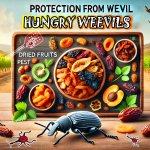Tomatoes: Juicy Fruits and Protection from Weevil Pests
12 Nov 2024

Tomato: The King of Vegetable Gardens
Tomato is one of the most popular and beloved vegetables in the world. Its juicy flesh, rich in vitamin C and antioxidants, gives a unique taste to many dishes. Tomatoes are eaten fresh, added to salads, sauces, used for making juices and canning.
Weevils and tomatoes: myth or reality?
Direct answer: weevils, as a rule, do not feed on fresh tomatoes. Their diet most often consists of grains, legumes and other plants. However, some types of weevils can damage young tomato shoots, but this is the exception rather than the rule.

But dried tomatoes can become a target for other pests:
Moth: Moths lay eggs in dried tomatoes, and the hatched larvae feed on the pulp.
Carpet Beetles: These insects can also damage dried tomatoes by chewing holes in them.
Why are dried tomatoes attractive to pests?
Sugar Residues: The drying process leaves behind sugars in tomatoes that attract insects.
Dry Environment: Dry conditions create a favorable environment for pests to reproduce and develop.
How to Protect Dried Tomatoes from Pests
To keep dried tomatoes fresh and pest-free, follow these guidelines:
Play the game regularly - Hungry Weevils
Airtight Packaging: Store dried tomatoes in airtight containers or vacuum bags.
Dry Place: Choose a cool, dry place for storage that is inaccessible to insects.
Regular Inspection: Check dried tomatoes periodically for damage and pests.
Freezing: For long-term storage, dried tomatoes can be frozen.
Heat Treatment: Dried tomatoes can be lightly fried or boiled before consumption.
Conclusion
Tomatoes are not only tasty, but also healthy. Although fresh tomatoes are not susceptible to weevils, dried tomatoes can become a target for other pests. By following simple storage rules, you can protect dried tomatoes and enjoy their taste.
Related games
Related news
Hungry Weevils: Live Stream of the Game That Captured Player...
Players are excited about Hungry Weevils – details from the latest stream
Read moreDried Fruits: A Sweet Danger for Weevils
Dried Fruits: A Concentrate of HealthDried fruits are a concentrated source of vitamins, minerals, fiber, and, of cours...
Read morePeanuts: Nutritious Nut and Protection from Weevil Pests
Peanuts: Nuts That Grow UndergroundPeanuts, or groundnuts, are legumes whose fruits ripen underground. They are rich in...
Read more




